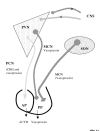Clinical review: Vasopressin and terlipressin in septic shock patients
- PMID: 15774080
- PMCID: PMC1175907
- DOI: 10.1186/cc2945
Clinical review: Vasopressin and terlipressin in septic shock patients
Abstract
Vasopressin (antidiuretic hormone) is emerging as a potentially major advance in the treatment of septic shock. Terlipressin (tricyl-lysine-vasopressin) is the synthetic, long-acting analogue of vasopressin, and has comparable pharmacodynamic but different pharmacokinetic properties. Vasopressin mediates vasoconstriction via V1 receptor activation on vascular smooth muscle. Septic shock first causes a transient early increase in blood vasopressin concentrations; these concentrations subsequently decrease to very low levels as compared with those observed with other causes of hypotension. Infusions of 0.01-0.04 U/min vasopressin in septic shock patients increase plasma vasopressin concentrations. This increase is associated with reduced need for other vasopressors. Vasopressin has been shown to result in greater blood flow diversion from nonvital to vital organ beds compared with adrenaline (epinephrine). Of concern is a constant decrease in cardiac output and oxygen delivery, the consequences of which in terms of development of multiple organ failure are not yet known. Terlipressin (one or two boluses of 1 mg) has similar effects, but this drug has been used in far fewer patients. Large randomized clinical trials should be conducted to establish the utility of these drugs as therapeutic agents in patients with septic shock.
Figures


References
-
- Okamura T, Toda M, Ayajiki K, Toda N. Receptor subtypes involved in relaxation and contraction by arginine vasopressin in canine isolated short posterior ciliary arteries. J Vasc Res. 1997;34:464–472. - PubMed
-
- Landry DW, Levin HR, Gallant EM, Ashton RC, Jr, Seo S, D'Alessandro D, Oz MC, Oliver JA. Vasopressin deficiency contributes to the vasodilation of septic shock. Circulation. 1997;95:1122–1125. - PubMed
-
- Laszlo FA, Laszlo F, Jr, De Wield D. Pharmacology and clinical perspectives of vasopressin antagonists. Pharmacol Rev. 1991;43:73–108. - PubMed
Publication types
MeSH terms
Substances
LinkOut - more resources
Full Text Sources
Other Literature Sources
Medical

